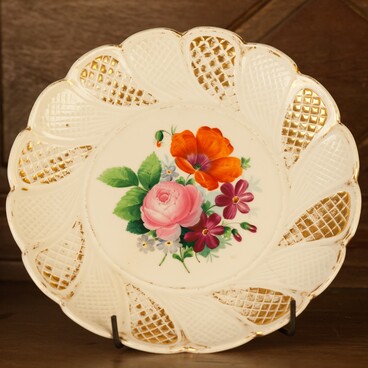The door to the State Dining Room was mounted in Massandra palace in 1900. The door leaf is made of oak and embellished with eleven clean-cut geometric inlays. The upper part of the door leaf holds nine inlays of lighter-colored wood, eight of which are decorated with a pattern of scrolls and flowers touched up with oil paint.
In the center there is a rectangular inlay with a pyrographic geometric motif. Below it there is a line of carved-in rosettes.
Intarsia is a woodworking technique which inlays sections of wood within the solid matrix of a wooden object (mostly furniture) to create a mosaic pattern. These inlaid sections differ in shapes and sizes and usually contrast with the matrix in color or material. Intarsia is one of the oldest decorative arts in the Eastern and Central Asia. It reached the apex of its popularity in Renaissance Italy in the 15th century, and in the rest of Europe in the 16-17th centuries.
When it is required to combine materials of different durability, intarsia is a preferred and time-tested craft. An intarsia-like technique was used as far back as Ancient Egypt to decorate precious boxes, chests, ebony or cedar furniture and even sarcophagi with sintered quartz, lapis lazuli, ivory, bone, tortoise shell or mother-of-pearl.
In the 18-19th centuries intarsia was gradually supplanted by a less complex marquetry woodwork. In this regard, the door leading from the Billiard Room to the State Dining Room of Massandra palace is quite unique as it is decorated with a genuine example of intarsia.
The lower part of the door leaf is decorated with narrow rectangular inlays decorated with stylized floral patterns. The door design resonates with the oak paneling of the Billiard Room and with the fireplace.
The door was created by Olga Beideman, an artist from Saint Petersburg. She was the daughter of Alexander Beideman, a famous painter and a professor of historical painting in the Imperial Academy of Fine Arts. Olga Beideman studied in Baron von Stieglitz’s Central School of Technical Drawing and graduated top of her class. It was in that school that she learned intarsia as it had been recently added to the school syllabus.
In the center there is a rectangular inlay with a pyrographic geometric motif. Below it there is a line of carved-in rosettes.
Intarsia is a woodworking technique which inlays sections of wood within the solid matrix of a wooden object (mostly furniture) to create a mosaic pattern. These inlaid sections differ in shapes and sizes and usually contrast with the matrix in color or material. Intarsia is one of the oldest decorative arts in the Eastern and Central Asia. It reached the apex of its popularity in Renaissance Italy in the 15th century, and in the rest of Europe in the 16-17th centuries.
When it is required to combine materials of different durability, intarsia is a preferred and time-tested craft. An intarsia-like technique was used as far back as Ancient Egypt to decorate precious boxes, chests, ebony or cedar furniture and even sarcophagi with sintered quartz, lapis lazuli, ivory, bone, tortoise shell or mother-of-pearl.
In the 18-19th centuries intarsia was gradually supplanted by a less complex marquetry woodwork. In this regard, the door leading from the Billiard Room to the State Dining Room of Massandra palace is quite unique as it is decorated with a genuine example of intarsia.
The lower part of the door leaf is decorated with narrow rectangular inlays decorated with stylized floral patterns. The door design resonates with the oak paneling of the Billiard Room and with the fireplace.
The door was created by Olga Beideman, an artist from Saint Petersburg. She was the daughter of Alexander Beideman, a famous painter and a professor of historical painting in the Imperial Academy of Fine Arts. Olga Beideman studied in Baron von Stieglitz’s Central School of Technical Drawing and graduated top of her class. It was in that school that she learned intarsia as it had been recently added to the school syllabus.



